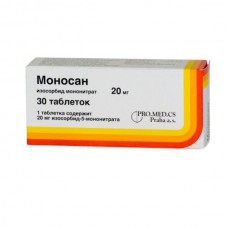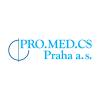Expiration date: 12/2026
The composition and form of issue:
Tablets. 1 tablet contains active substance:
isosorbide-5-Mononitrate 20 or 40 mg
(triturate isosorbide-5-Mononitrate and lactose monohydrate in the ratio of 80% : 20% 25 mg or 50 mg)
other ingredients: microcrystalline cellulose corn starch magnesium stearate lactose granulated talc
blistere in 10 PCs. in cardboard pack 3 blisters.
Description pharmaceutical form:
Round, flat tablets white or almost white scored one side.
Pharmacokinetics:
After intake of isosorbide Mononitrate is rapidly and completely absorbed from the gastrointestinal tract. Has a high oral bioavailability — approximately 100%, because there is no effect of "first passage" through the liver. Cmax in blood plasma after administration of the drug inside achieved within 1 h. Individual differences in plasma concentrations after ingestion of the drug inside a small. The effective level of the isosorbide Mononitrate in the blood is about 100 mg/ml. the Drug is not associated with blood plasma proteins. Pharmacokinetics at doses of 10-80 mg has a linear character. Unlike isosorbide dinitrate, it is metabolized not in the liver, and the kidneys, where the formation of isosorbide and its two glucuronide isosorbide-5-Mononitrate. T1/2 is about 4-5 hours Excreted by the kidneys, mainly in the form of glucuronic metabolites, 2% in unaltered form. The renal clearance of the drug to 115 ml/min In hepatocellular and renal insufficiency, the pharmacokinetics of isosorbide Mononitrate does not change significantly.
Description pharmacological action:
Peripheral vasodilator with a predominant effect on venous vessels. Stimulates the formation of nitric oxide (endothelial relaxing factor) in the vascular endothelium, causing activation of intracellular called guanylate cyclase, resulting in an increase in cGMP (mediator of vasodilation). Reduces the need of myocardium in oxygen by reducing preload and postnagruzki. Has coronary dilator action. Reduces blood flow to the right atrium, reduces the pressure in the pulmonary circulation and regression of symptoms oteke light. Promotes redistribution of coronary blood flow in the area with reduced blood circulation. Increases tolerance to physical load in patients with ischemic heart disease, angina. Dilates blood vessels of the brain, the Dura mater, which may be accompanied by headache. Inhibits platelet aggregation, reduces thromboxane synthesis vnutritrombozitarnyi. As with other nitrates, develops cross-tolerance. After a cancellation (interruption of treatment) sensitivity to it quickly restored. Antianginal effect occurs within 30-45 minutes after ingestion and lasts up to 8-10 hours
Indications:
- Coronary artery disease: prevention of angina attacks
- chronic heart failure (in combination therapy).
Contraindications:
- hypersensitivity to organic nitrates or other components of the drug
- acute circulatory disorders (shock, vascular collapse)
- cardiogenic shock, unless there is a fairly high end-diastolic pressure in the left ventricle by applying an intra-aortic pump therapy or due to the introduction of funds, providing a positive inotropic effect
- toxic pulmonary edema
- expressed arterial gipotenzia (sad less than 100 mm Hg.St., DBP is less than 60 mm Hg.St.)
- concomitant use of inhibitors of phosphodiesterase-5, including sildenafil, vardenafil, tadalafil, as they potentiate the antihypertensive effect of nitrates
- hereditary intolerance of galactose, lactase deficiency or malabsorption syndrome of glucose and galactose
- the age of 18 years (efficacy and safety not established).
With caution
- hypertrophic cardiomyopathy, constrictive pericarditis, pericardial tamponade
- low filling pressure in acute myocardial infarction, left ventricular failure. You should not reduce the garden less 90 mm Hg. article
- aortic and/or mitral stenosis
- tendency to orthostatic disorders of vascular regulation
- angle-closure glaucoma
- thyrotoxicosis
- severe anemia
- diseases accompanied by increased intracranial pressure (including hemorrhagic stroke, TBI)
- renal insufficiency
- liver failure.
Application of pregnancy and breast-feeding:
For security reasons Monosan can be used during pregnancy and lactation only strictly on prescription, after a careful evaluation of benefits and possible risks, as to date insufficient data on the implications of the pregnant and lactating mothers. If a nursing mother still takes Monosan, you must install the monitoring of the child on the subject of possible effects of the drug.
Side effects:
From the CCC: "nitrate" headache, dizziness, transient hyperemia of the skin, sensation of heat, tachycardia, marked reduction in blood pressure in rare cases — increased angina (paradoxical reaction), orthostatic collapse.
From the digestive system: nausea, vomiting, may cause slight burning sensation of the tongue, dry mouth.
CNS: stiffness, drowsiness, blurred vision, decreased ability to rapid mental and motor reactions (especially at the beginning of treatment).
Allergic reactions: skin rash in some cases, — exfoliative dermatitis.
Other: the development of tolerance (including cross-to other nitrates).
Drug interactions:
Increases the concentration of dihydroergotamine in plasma.
It reduces the effect of vasopressors.
Barbiturates accelerate the biotransformation and reduce the concentration of isosorbide Mononitrate in the blood.
In a joint application with other vasodilators, ACE inhibitors, beta-blockers, CCB, diuretics, neuroleptics or tricyclic antidepressants, inhibitors of phosphodiesterase-5, including sildenafilum, vardenafilom, tadalafilum, as well as with ethanol may potentiate the antihypertensive effect of isosorbide Mononitrate.
When combination with amiodarone, propranolol, CCB (verapamil, nifedipine, etc.) may increase the anti-anginal effect.
Under the influence of beta-agonists, alpha-adrenergic blocking agents (dihydroergotamine, etc.) may reduce the severity of antianginal effect (tachycardia, excessive decrease in blood pressure).
With the combined use of m-anticholinergics (atropine, etc.) increases the likelihood of raising intraocular pressure.
Adsorbents, binders and enveloping means reduce the absorption of isosorbide Mononitrate in the digestive tract.
The therapeutic effect norepinephrine (noradrenaline) decreases at simultaneous reception with the nitrocompounds.
Method of application and dose:
Inside, after food, swallowed whole, squeezed small amount of liquid.
The dose and frequency of reception set individually, depending on the severity of the disease. Start with 10-20 mg 1-3 times a day (dose 10 mg with 1/2 tablet of 20 mg). Depending on the severity of the clinical effect with 3-4 days of therapy the dose can be increased to 20-40 mg 2 times a day, increasing the dose if necessary up to 60 mg/day (tablets 20 mg) to 80 mg/day (tablets 40 mg). The maximum daily dose — 80 mg.
Overdose:
Symptoms: collapse, syncope, reflex tachycardia, weakness, dizziness, confusion, headache, visual disturbances, hyperthermia, skin redness, increased sweating, nausea, vomiting, diarrhea, methemoglobinemia (cyanosis, anoxia — usually in chronic overdose), hyperpnoea, dyspnoea, increased intracranial pressure, convulsions, paralysis, coma.
Treatment: in addition to General recommendations, such as gastric lavage and placing the patient in horizontal position with raised legs, it should monitor the main indicators of vital functions and, if necessary, to correct them. Patients with severe hypotension and/or shock should restore the volume of circulating blood, in exceptional cases, to improve circulation to infusion of norepinephrine and/or dopamine.
Introduction epinephrine (adrenaline) and related compounds are contraindicated. If methemohlobinemia depending on the severity assigned/ascorbic acid in the form of sodium salts (formerly used methylthionine chloride (methylene blue) of 0.1–0.15 ml/kg of 1% solution to 50 ml) oxygen therapy, haemodialysis, exchange transfusion.
Special instructions:
The drug is not used for the relief of angina.
During therapy required monitoring of blood pressure and heart rate. In case you need to use the drug on the background of arterial hypotension, should take drugs with a positive inotropic effect. Common purpose and high doses can cause the development of tolerance in this case, after 3-6 weeks of regular admission, it is recommended that removal of the drug for 24-48 h, or a break in drug treatment Menosan for 3-5 days and its replacement with other antianginal drugs.
It is necessary to avoid abrupt discontinuation of the drug and reduce the dose gradually.
During the period of drug treatment should exclude alcohol.
Possible decreased ability to rapid mental and motor reactions, so be careful to drive vehicles and engage in potentially hazardous activities during the period of drug therapy.



